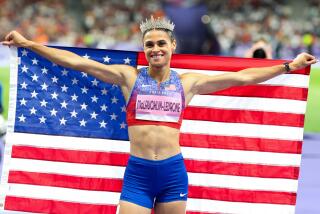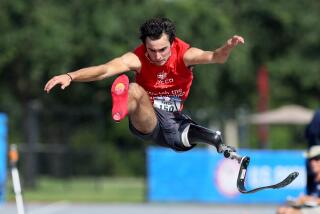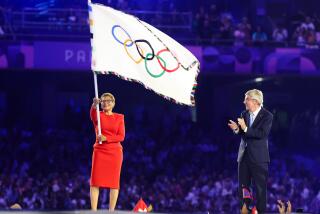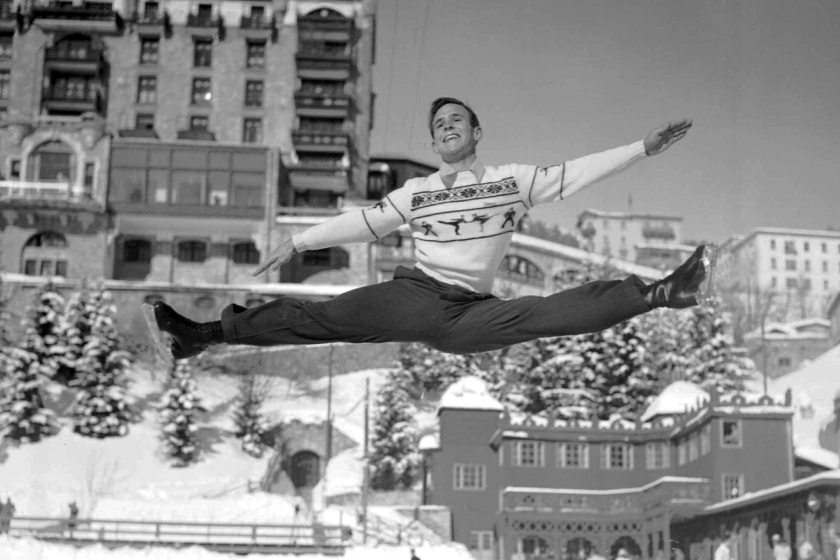Track and Field : U.S. High Jumpers Beat the Odds, Reach Rome Meet
- Share via
The odds that Jerome Carter, Lee Balkin and Thomas McCants would represent the U.S. in the high jump in the World Championships next month at Rome were comparable to the odds of winning in Lotto 6/49.
Each high jumper has some credentials, but none of them figured to finish in the top three places in the recent USA/Mobil outdoor championships at San Jose and thereby qualify for Rome. Only Carter was ranked among the top 10 U.S. high jumpers in 1986, as No. 8.
Jimmy Howard, the American record-holder at 7 feet 8 3/4 inches, didn’t make the team. Neither did Doug Nordquist, who was ranked No. 3 in the world last year, or veteran Dwight Stones, a two-time Olympic bronze medalist.
Such is the nature of the high jump, an event that is consistent for its inconsistency.
It was even more surprising that Balkin, a former UCLA athlete, made the team, considering that there was some question whether he would ever walk normally again after ankle surgery in 1982.
But Balkin cleared 7-7, a personal record, for second place. Carter won at 7-7 on the basis of fewer misses at lower heights, and McCants was third at 7-5 3/4.
Balkin came to UCLA from Glendale High School, where Stones was first noticed. Balkin was a blue chip prep prospect, having won the State championship and finishing first in the National Junior meet in 1979 with a best mark of 7-3 .
Balkin’s career at UCLA seemed to be progressing on schedule until he was bothered by a bone spur in his left ankle, his plant leg for the high jump.
So, while redshirting in 1982, he had surgery. It was not considered a complicated operation, but there were complications.
“An infection developed under the cast, and there was tremendous pain in the ankle,” Balkin said. “By the time they opened it up, there was an extremely complicated infection throughout the ankle joint.
“After that I was just sitting in a hospital room for a better part of a month with antibiotics running through me every four hours.
“A doctor told me that I probably wouldn’t be competing again. I just hoped that I could lead a normal life at that point, thinking that jumping would be out.”
Balkin was jumping again in 1983, though. He said he had a lackluster season and was competing with pain. In 1984, he improved to some extent and made the finals in the U.S. Olympic trials.
“However, it wasn’t until 1985 that I could compete when or how I wanted to, as the pain subsided somewhat,” he said.
Balkin, 26, established a personal best of 7-6 1/2 in the Pepsi Invitational that year and finished second in The Athletics Congress meet.
He said he lost some motivation in 1986 and considered leaving jumping to others. He had his real estate license and was ready to go into business.
“Then, I became the assistant track coach at Glendale College last January,” Balkin said. “Working out with the athletes got me into tremendous shape. “
So while other, more celebrated jumpers failed in windy conditions at San Jose, Balkin soared to 7-7.
The bar then went up to an American-record height of 7-9 . But Balkin and Carter didn’t go any higher.
“I came to the meet with two goals--either to finish in the top three, or jump 7-7. I had achieved both of them,” Balkin said. “So some of my adrenaline was lost. I would have to have a little more mental preparation to jump that high (7-9 ).”
Sweden’s Patrik Sjoberg was certainly prepared, though, as he established a world high jump record of 7-11 Tuesday at Stockholm.
Only two Americans, Howard and Nordquist, were ranked among the top 10 in the world last year. Several jumpers, mainly Europeans, have jumped 7-9 or higher, but the Americans are lagging behind.
Stones was the last American to hold the world outdoor record, and that was 10 years ago.
So, the American high jumpers don’t figure to threaten the Europeans in Rome. Balkin, however, has already overcome greater odds.
Carl Lewis said Wednesday that his leg injury isn’t serious and he expects to start running again next week.
Lewis suffered a hyper-extended left knee while long jumping in the national championship meet, and a hamstring injury to the same leg prevented him from going all out in the 100 meters.
Nonetheless, he won the long jump and 200 meters and was a close second behind Mark Witherspoon in the 100.
“Technically, I didn’t do a good job starting in the 100,” Lewis said. “If I had exploded out of the blocks, there was a possibility I could pop that hamstring. I felt the hamstring every step of the way, and I just told myself to stay relaxed. I was really frustrated because I was ready to run a good time.’
As it was, his time wasn’t shabby, 10.05 seconds. Witherspoon posted a 10.04.
“I know I can run faster, and that, in turn, will make Mark run faster,” Lewis sad.
Witherspoon trains with Lewis in Houston, and both are members of the Santa Monica Track Club.
Lewis said he has three meets scheduled this month. He plans to run the 100 at Paris July 16, the 200 at the Hengelo, the Netherlands, July 19 but is undecided about which event he’ll select for a meet at Rome July 22.
Then, he’ll concentrate on the long jump in the Pan American Games at Indianapolis, where the track and field events are scheduled Aug. 9-16.
“I’ll only be running in the finals of the 400-meter relay in order to jump well,” Lewis said. “It’s my opportunity, my place and my time.”
And will this finally be the place and time that Bob Beamon’s 19-year-old record of 29-2 1/2 is finally surpassed by Lewis?
Mark Nenow, the American record-holder in the 10,000 meters with the third-best time in the event, 27:20.56, passed up the national championship meet to compete Tuesday at Stockholm.
He told Pat Butcher of the London Times that track and field is dead in the United States, without much fan interest or support from television.
The Americans could use Nenow in Rome Aug. 29-Sept. 6 because of the dominance of foreign long-distance runners. He doesn’t help solve anything by dropping out of the American track scene.
More to Read
Go beyond the scoreboard
Get the latest on L.A.'s teams in the daily Sports Report newsletter.
You may occasionally receive promotional content from the Los Angeles Times.







